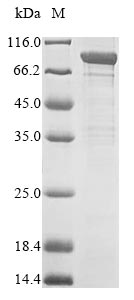CUSABIO synthesized the recombinant gene by integrating the N-terminal 6xHis tag sequence into the targeted gene encoding the 1-732aa of the human APEH. The synthesized gene was subsequently cloned into an expression vector. After cloning, the expression vector was introduced into the E.coli for expression. The product was purified to obtain the recombinant human APEH protein carrying N-terminal 6xHis tag. The SDS-PAGE assayed the purity of this recombinant APEH protein greater than 85%. This APEH protein migrated along the gel to a band of about 90 kDa molecular weight.
APEH is a gene providing instruction of making a protein called acylamino-acid-releasing enzyme in human and belongs to peptidase S9C family. This protein, also abbreviated APH or AARE, is a tetrameric serine protease which specifically removes acetyl amino acids from N-terminally acetylated peptides and play an important role in destroying oxidatively-damaged proteins in living cells. APH preferentially cleaves off Ac-Ala, Ac-Met and Ac-Ser. Deletions of this gene locus are found in various types of carcinomas, including small-cell lung carcinoma and renal cell carcinoma.






